04.12.2006
K.Sakaev comments on the games of Kramnik vs Deep Fritz match
V.Kramnik (2750) – DEEP FRITZ [E03]
Game 1, 25.11.2006
1.d4 ¤f6 2.c4 e6 3.g3 d5. As we can see Fritz plays solidly in the opening. From the spectator's standpoint it would be more interesting to watch the fight in the Benko Gambit or the King's Indian or the Gruenfeld Defence. Or in any other opening where complex and asymmetrical positions arise.
4.Ґg2 dxc4 5.Јa4+! An excellent anti-computer move! In the event of the normal 5.¤f3 Black has many options including the variations when it holds the extra pawn on c4. Kramnik's plans can't involve such a sharp play. Now a position arises with no advantage for White but men can and should outplay computers in the structure with the exchange of the c and d pawns. I noticed it long ago and Vladimir's choice of such a line has merely consolidated my belief.
5...¤bd7 6.Јxc4 a6 7.Јd3. The queen is taken away from b7-b5, another possible retreat is 7.Јc2 which Vladimir will try in Game 3.
7...c5 8.dxc5. The bishop is visibly active on c5 however placing it there doesn't make much sense. Actually it stands better on e7 therefore White isn't afraid to lose a tempo and urge its development on.
8...Ґxc5 9.¤f3 0–0 10.0–0 Јe7. Weaker is10...b6 11.¤g5! (to 11.¤e5 Black calmly covers the diagonal by 11...¤d5) 11...¦a7 12.¤c3 ¤e5 13.Јc2. The knight from g5 goes to e4, and in view of the positional threat to exchange one of the black bishops White is slightly better.
11.¤c3 b6

12.¤e4. Anovelty. The move 12.¤g5 played before in the game Szekely,P – Salov,V (1984) isn't dangerous for Black due to 12...¤e5 [an interesting line 12...Ґb7!? 13.¤xh7 ¤xh7 (in case of 13...Ґxg2 14.¤xf6+ ¤xf6 15.ўxg2 ¦fd8 16.Јf3 Black's compensation for a pawn is insufficient) 14.Ґxb7 Ґxf2+ 15.¦xf2 ¤c5 leads to double-edged play] 13.Јb1 (13.Јc2 Ґb7 can only be inferior because the white queen may be exposed to the influence of the rook c8) 13...Ґb7 14.¤ce4 ¤xe4 15.Ґxe4 ¤g6 16.Ґxb7 Јxb7 17.Јe4 with a full equality.
12...¤xe4 13.Јxe4 ¤f6 14.Јh4! In the line 14.Јxa8 Ґb7 15.Јxf8+ ўxf8 Black is actually better but only because of its pieces' activity. Otherwise an advantage would have been with White.
14...Ґb7 15.Ґg5 ¦fd8 16.Ґxf6. 16.¦fd1 ¦xd1+ 17.¦xd1 ¦d8 leads to the same equal position.
16...Јxf6. One may be surprised that the computer chooses a continuation which simplifies the game. 16...gxf6!? with a rather complicated play looked more interesting.
17.Јxf6 gxf6 18.¦fd1

18...ўf8?? A typical computer's lack of chess understanding! It wants to preserve the advantage of the bishop pair just for one move! For a grandmaster it is obvious that the position calls for 18...Ґxf3 19.Ґxf3 ¦ab8. Then Black puts the pawn on a5 and starts frittering away the time. In fact it's time to agree to a draw. Now after the exchange of the light-squared bishops Black has problems with its spoiled pawn formation on the kingside moreover the pawn on b6 is misplaced as in endings pawns should stand on the squares opposite to the colour of their bishop.
19.¤e1 Ґxg2 20.ўxg2 f5 21.¦xd8+ [the preliminary 21.¦ac1 also maintains the edge] 21...¦xd8 22.¤d3. Here the knight is placed perfectly – the d-file is covered, the b-pawn is protected and the c-file is cleared.
22...Ґd4 23.¦c1

23...e5?! From the human standpoint this decision is very committal and risky. 23...a5! looks more reliable depriving the knight of the b4 square. Later on Black already may move its king to e7 or to think of e6-e5.
24.¦c2 ¦d5. 24...a5 still looks more logical.
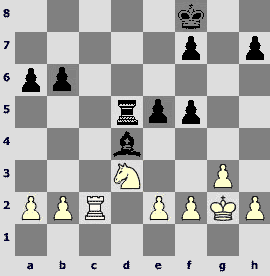
25.¤b4! Vladimir assesses very subtly that after the rooks exchange he will preserve the advantage on account of Black's weakened light squares and the f5 pawn in particular.
25...¦b5. Bad is 25...¦c5 26.¦xc5 bxc5 27.¤xa6 c4 28.b3 c3 29.¤b4. After blocking the c3 pawn White should gradually win.
26.¤xa6 ¦xb2. No better is 26...Ґxb2 27.¤c7 (27.a4 ¦a5 28.¤b8 Ґd4 29.¦c4 b5) 27...¦c5 28.¦xc5 (the rook ending after 28.¦xb2 ¦xc7 29.¦xb6 ¦c2 is drawn) 28...bxc5 29.a4. Black is in serious troubles e.g. 29...c4 30.a5 Ґd4 31.¤b5 c3 32.¤xd4 exd4 33.a6 c2 34.a7 c1Ј 35.a8Ј+ ўg7 36.Јd5 or 29...ўe7 30.¤d5+ ўe6 31.¤b6.
27.¦xb2 Ґxb2 28.¤b4 ўg7 29.¤d5. The knight is excellently placed on d5. It attacks the b6 pawn and at the same time prevents the black king from moving towards the centre.
29...Ґd4. Unfortunately for Black it can't play 29...b5 in view of 30.¤c7 b4 31.¤d5, and the bishop doesn't arrive in time at c5 being forced to take an awful position on c3 or a3 instead.
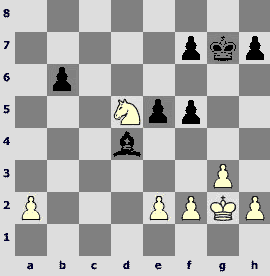
30.a4! The weakness on b6 is fixed up.
30...Ґc5 31.h3?! This move turns out to be a waste of time. White is unable to carry out g3-g4 under favourable circumstances as it always runs into h7-h5 which allows Black to exchange yet another pair of pawns. Much more dangerous was 31.f3! White has several possible plans here depending on Black's actions: to 31...f6 (with idea to bring the king near via f7 to e6) strong is 32.e4, while to 31...h5, 32.e3 isn't bad e.g. 32...f6 33.ўf1 ўf7 34.ўe2 ўe6 35.¤c7+ ўd7 36.¤b5 – the white king comes to d3 and Black's defence is difficult.
31...f6 32.f3 ўg6. 32...h5 didn't change anything. Now if 33.e4, then 33...ўg6 transposing to the game.
33.e4 h5. Alas thereare too little pieces on the board and the draw is unavoidable.
34.g4 hxg4 35.hxg4 fxe4 36.fxe4 ўg5 37.ўf3 ўg6 38.ўe2 ўg5 39.ўd3 Ґg1 40.ўc4 Ґf2 41.ўb5 ўxg4 42.¤xf6+ ўf3 43.ўc6 Ґh4 44.¤d7 ўxe4 45.ўxb6 Ґf2+ 46.ўc6 Ґe1 47.¤xe5. Draw agreed.
What a pity! Vladimir Kramnik played an anti-computer variation and conducted the game very subtly although without ostentatious effects. Unfortunately the single inaccuracy stultified all his hard work.
DEEP FRITZ – V.Kramnik (2750) [D20]
Game 2, 27.11.2006
1.d4 d5 2.c4 dxc4 3.e4 b5!? A very rare move. One may suggest that it was a surprise for the computer!
4.a4 c6 5.¤c3 b4 6.¤a2 ¤f6 7.e5 ¤d5 8.Ґxc4 e6. ThegamehasbeentransposedintotheSlavDefence. Not long ago the given variation was considered to be advantageous for White but now it enjoys the second heyday.
9.¤f3 a5. Sometimes Black tries to save a tempo playing 9...Ґe7 first, but then all the same he is forced to play a7-a5. Vladimir believes that the immediate 9...a5 is more precise – perhaps in some lines Black would advance c6-c5 with the bishop on f8, and in case of the exchange on this square it is him who wins a tempo.
10.Ґg5?! The main theoretical continuation. The computer exploits its opening base but so far without a great success. The move h7-h6 is very useful for Black so there's no point in provoking it. The simple 10.0–0 is more logical.
10...Јb6 11.¤c1 Ґa6 12.Јe2 h6 13.Ґe3?
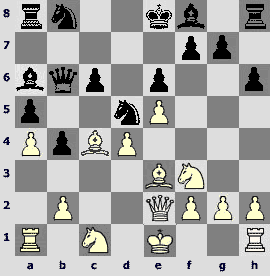
A serious positional mistake. White temporarily stops c6-c5, but it can't prevent it in the long term. The realization of this advance which frees Black's play is inevitable. That's when the bishop's position on e3 will tell. It has been exposed to the exchange here and it also weakens the dark squares in White's camp.
13...Ґxc4 14.Јxc4 ¤d7 15.¤b3 Ґe7 16.¦c1 0–0 17.0–0
17.Јxc6 leads to a position where only White has problems: 17...Јxc6 18.¦xc6 ¤7b6 19.ўd2 ¤xa4 20.¦a1 ¤xb2 21.ўc2 a4 22.ўxb2 axb3 23.¦ca6 ¦xa6 24.¦xa6 ¦c8 25.Ґd2. Here Black has a pleasant choice between 25...ўh7 with idea to bring the king into play via g6 to f5 or the sharp 25...g5!? In both cases White faces a fight for a draw without many prospects.
17...¦fc8 18.Јe2 c5! 19.¤fd2
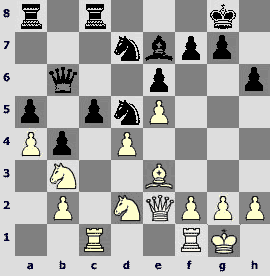
19...Јc6!! A brilliant move! Black doesn't try to simplify but takes the key pawn on a4 exploiting the fact that the bishop on e3 can be traded at any moment and therefore White has no attacking potential while the black a5 pawn will become terribly strong.
20.Јh5. 20.Јg4 didn't promise anything good either: 20...ўh8 21.Јf3 Јxa4 22.Јxf7 Јc6 23.¤c4 a4 24.¤xc5 ¤xc5 25.dxc5 ¤xe3 26.¤xe3 Ґxc5, and the a-pawn should decide the outcome.
20...Јxa4 21.¤xc5 ¤xc5 22.dxc5 ¤xe3 23.fxe3 Ґxc5 24.Јxf7+ ўh8 25.Јf3. White has to remember about the weaknesses in its camp created by 13.Ґe3? The computer is unable to foresee and correctly estimate a position after 12 unforced moves...
25...¦f8 26.Јe4 Јd7 27.¤b3 Ґb6 28.¦fd1 Јf7 29.¦f1 Јa7! Black justly rejects the repetition. 30.¦xf8+ ¦xf8 31.¤d4

31...a4? An unexpected and incomprehensible miscalculation. The simplest 31...Ґxd4 32.exd4 (no better is 32.Јxd4 Јf7, and White is actually a pawn down) 32...a4 allowed to play for a win without any risk. I think this position should rather be lost for White. Of course it was possible to maintain the tension but not the way it was made in the game but by the simple 31...Јf7, which would also preserve Black's indisputable edge.
32.¤xe6 Ґxe3+ 33.ўh1 Ґxc1. From the human standpoint stronger was 33...¦e8 but being played against the computer these two moves have the same value. After 34.¦f1 (to 34.¦d1 Black has a strong reply 34...a3!) 34...Јa6 35.¦e1 Јxe6 36.Јxe3 Јe7 37.e6 a3 38.bxa3 bxa3 Black's position is better but... it is drawn! The computer would hardly err here.
34.¤xf8 Јe3?? It's hard to understand what happened. A logical finale would have been 34...ўg8 35.¤g6 Јe3 36.Јd5+ ўh7 37.¤f8+ ўh8 with a draw by repetition.
35.Јh7#
Very pity again! Vladimir Kramnik thought over the opening profoundly, then outplayed the monster (true by 13.Ґe3? the monster outplayed itself to some extent) while the courageous and very precise move 19...Јc6!! could yield Black the victory – in any case he doesn't run a risk of losing and for White the distance between a loss and a draw was very insignificant. What happened in the end of the game nobody could comprehend. It may only be noticed that playing against computers is a very special thing and mistakes correspond to it.
V.Kramnik (2750) – DEEP FRITZ [E03]
Game 3, 29.11.2006
1.d4 ¤f6 2.c4 e6 3.g3 d5 4.Ґg2 dxc4 5.Јa4+ ¤bd7 6.Јxc4 a6 7.Јc2. VladimirtriestoslightlydeviatefromGame 1.
7...c5 8.¤f3 b6 9.¤e5 ¤d5 10.¤c3 Ґb7 11.¤xd5
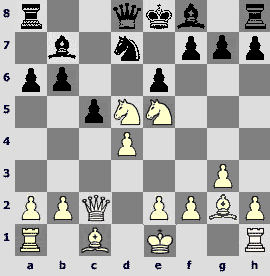
11...Ґxd5. A quite logical novelty. Before, for some reason Black played only 11...exd5, but the bishops opposition along the main diagonal favours White: 12.0–0 Ґe7 13.¤xd7 Јxd7 14.Јb3 Јe6 15.dxc5 Ґxc5 16.e3 0–0 17.Ґd2, and Black faces a cheerful defence, Akopov,R – Frumson,Y/Smolensk 1991.
12.Ґxd5 exd5 13.0–0 [13.Ґf4 f6! 14.¤xd7 Јxd7 doesn't promise anything ] 13...¤xe5 14.dxe5 Јc8! A very strong decision, the queen's place is at e6. 14...Јd7 15.¦d1 Јe6 leads to a transposition. After 14...Јe7 15.e4! d4 16.f4! Јe6 17.f5! Јxe5 18.Ґf4 the play is quite different, White has an initiative.
15.¦d1 Јe6 16.Јd3 Ґe7! Black obtains a sufficient compensation for a pawn. If 16...d4 17.e3 dxe3 18.Ґxe3, and White is somewhat better.
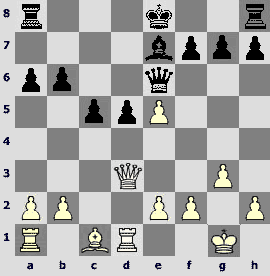
17.Јxd5 ¦d8 18.Јb3 ¦xd1+ 19.Јxd1 0–0 20.Јb3 c4 21.Јc3 f6. From the practical standpoint 21...b5!? is more unpleasant and if 22.b3, then 22...¦c8, strengthening the position on the queenside. True White has an extra pawn and it's early to shed tears.
22.b3! White tries to lessen the value of the black avalanche
22...¦c8 23.Ґb2 b5 24.Јe3 fxe5 25.bxc4 ¦xc4 26.Ґxe5 h6!
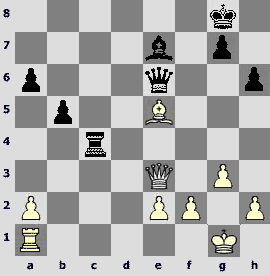
A very precious feature of a computer is its ability to maintain pressure even when there is almost no pressure at all. In such a position it's extremely difficult to play against a computer.
27.¦d1 ¦c2 28.Јb3! Undoubtedly Vladimir saw that the resulting ending is unpleasant but at the same time he correctly evaluated it as a drawn.
28...Јxb3 29.axb3 ¦xe2 30.Ґd6. Another option is to support the bishop by 30.f4, and White should hold as well.
30...Ґf6 31.Ґc5 a5 32.Ґd4 Ґe7. Of course all the rook endings with a remote king on g8 and the equal number of pawns are drawn.
33.Ґc3 a4 34.bxa4 bxa4 35.¦d7 Ґf8 36.¦d8 ўf7 37.¦a8
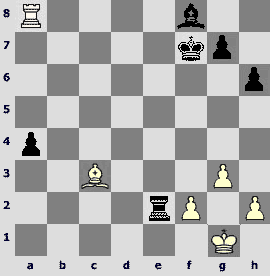
37...a3?! Computers often makes similar mistakes. More annoying is 37...¦e4, though after 38.¦a7+ the black king has no comfortable square to retreat and White should hold.
38.¦xf8+ ўxf8 39.Ґb4+ ўf7 40.Ґxa3 ¦a2 41.Ґc5 g6 42.h4 ўf6 43.Ґe3 h5 44.ўg2. Draw agreed.
In this encounter the computer played very well employing a novelty in the opening and skillfully maintaining the initiative throughout the game. In fact being White Vladimir without committing a single mistake found himself in an inferior position! Nevertheless he could display a high class and a desirable composure. Regarding the unlucky opening the draw should be considered as a good result.
